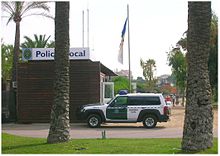Luis Roldan
Luis Roldán Ibáñez (born August 16, 1943 in Saragossa ) was the first civilian director of the Guardia Civil during the transition in Spain .
Life
State terrorist
Roldán joined the PSOE in Zaragoza in 1976. In 1979 he became Teniente de Alcalde (in the event of illness, absence, resignation or death of the mayor, authorized representative) of Saragossa. On December 29, 1982 he was appointed Commissioner of the Government of Navarre . In this position he showed success in the fight against the Euskadi Ta Askatasuna . On October 31, 1986 he was appointed Director General of the Guardia Civil by the Council of Ministers of the Government of Felipe González . The smashing of a tier group led by Francisco Múgica Garmendia alias Artapalo in Bidart was also counted as a success under his leadership . Roldán's term of office partially overlapped with the state terrorism of the Grupos Antiterroristas de Liberación (GAL) from 1983 to 1987. A member of this GAL was Francisco Paesa Sánchez .
When José Luis Corcuera became Minister of the Interior in 1988 , Roldán developed a modernization program for the state security forces. The traditional image of the guard in the three-pronged hat walking on the street has been replaced by the boy in the four-wheel drive . When Corcuera announced his resignation in November 1993 and Roldán applied for dismissal, the magazine Diario 16 exposed Roldán's conspicuous enrichment during his tenure.
Public procurement
Diario 16 reported that, with a salary of 600,000 pesetas per month in 1993, Roldán bought a chalet in Cizur Menor in Navarra , one in the Aravaca district of Madrid , an apartment of 332 square meters on Paseo de la Castellana , a plot of land in Cambrils and an orchard in Mequinenza , in La Rioja as well as other property titles that passed to his wife after his divorce. On December 3, 1993, Roldán's leadership of the Guardia Civil ended, and he was replaced by Ferrán Cardenal de Alemany, the then civil governor of Barcelona. On February 17, 1994, the General Assembly of the Spanish Parliament decided unanimously to set up a commission to investigate Roldán's administration with the Guardia Civil. This commission was constituted on March 1, 1994 and began its three-month work on March 10, 1994. On April 21, 1994, Roldán's membership in the PSOE was temporarily suspended until the case was resolved. Jorge Esparza Martín, Roldán's front man , appeared before the committee. On April 27, 1994, the public prosecutor's office justified an application to confiscate Roldán's passport from judge Ana María Ferrer with a growing number of suspicious facts.
Roldán, ni vivo ni muerto
On April 29, 1994, Roldán did not appear before the 16th Investigative Court in Madrid, as requested in his subpoena, whereupon the judge responsible issued an arrest warrant against Roldán. The security forces said they did not know where Roldán was. On April 30, 1994, Antoni Asunción Hernández , the Minister of the Interior, submitted his resignation on the grounds that he would assume political and technical responsibility for the escape. At the end of 1994 Manuel Vázquez Montalbán published a Pepe Carvalho crime story, which had the Roldán case on the subject: Roldán ni vivo ni muerto . Roldán was probably cheated of part of his booty by Paesa. Paesa then announced the whereabouts of Roldán to the Spanish police.
On February 27, 1995, Luis Roldán was arrested by Spanish police in the transit area of Bangkok's Suvarnabhumi Airport , where he had been extradited by the Lao authorities. On February 28, 1996, Roldán arrived in Madrid after a flight over Rome and was brought before judge Ana Ferrer, who ordered detention. On February 26, 1998, Roldán was sentenced to 28 years in prison for embezzlement, fraud, bribery and five public finance offenses. In addition, the Audiencia Provincial de Madrid fined him 1,600 million pesetas and ordered Roldán to pay the state two compensations of 578 million and 957 million pesetas.
In the appeal on December 21, 1999, the Supreme Court increased the sentence from 28 to 31 years. On February 28, 1995, Roldán was taken to Brieva Women's Prison in Ávila Province for security reasons .
Individual evidence
- ↑ El Mundo 24 de noviembre de 2002, LUIS ROLDÁN | EL RASTRO DE 1,600 MILLONES
- ↑ El Mundo 23 de mayo de 1994, Roldán informó a Corcuera y Solana de las necesidades militares angoleñas
- ↑ El Mundo 10 de mayo de 1997, Damborenea reitera que González “amparó” y “estimuló” los GAL
- ^ El Mundo 16 de Noviembre de 2004, Paesa desaparece de Luxemburgo y busca protección en Suiza
- ↑ El Mundo 15 de Noviembre de 2004, Francisco Paesa, el hombre que entregó a Roldán, sigue vivo seis años después de su presunta muerte
- ↑ El Mundo 18 de October 2004, LUIS ROLDÁN El primer civil al frente de la Benemérita
| personal data | |
|---|---|
| SURNAME | Roldan, Luis |
| ALTERNATIVE NAMES | Roldán Ibáñez, Luis |
| BRIEF DESCRIPTION | Spanish politician, director of the Civil Guard |
| DATE OF BIRTH | August 16, 1943 |
| PLACE OF BIRTH | Zaragoza |
